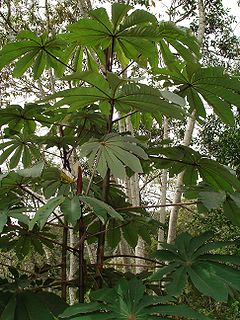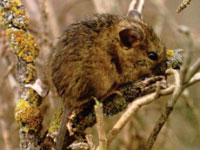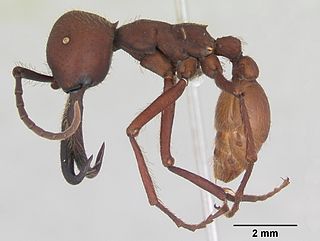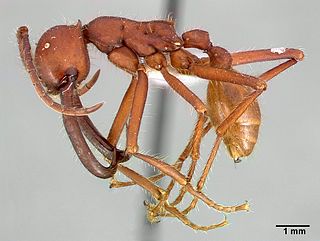
Cecropia is a Neotropical genus consisting of 61 recognized species with a highly distinctive lineage of dioecious trees. The genus consists of pioneer trees in the more or less humid parts of the Neotropics, with the majority of the species being myrmecophytic. Berg and Rosselli state that the genus is characterized by some unusual traits: spathes fully enclosing the flower-bearing parts of the inflorescences until anthesis, patches of dense indumentums (trichilia) producing Mullerian (food) at the base of the petiole, and anthers becoming detached at anthesis. Cecropia is most studied for its ecological role and association with ants. Its classification is controversial; in the past, it has been placed in the Cecropiaceae, Moraceae, or Urticaceae. The modern Angiosperm Phylogeny Group system places the "cecropiacean" group in the Urticaceae.

Uloboridae is a family of nonvenomous spiders, known as cribellate orb weavers or hackled orb weavers. Their lack of venom glands is a secondarily evolved trait. Instead, they wrap their prey thoroughly in silk, cover it in regurgitated digestive enzymes, and then ingest the liquified body.

Reithrodontomys is the genus of groove-toothed New World harvest mice.

Eciton vagans is a species of New World army ant in the genus Eciton. It occurs in dry and wet forest habitats, occupying a range extending from Mexico to throughout Costa Rica and possibly Panama and Colombia. Raids are always in columns and are distinguished in being usually nocturnal; preferred prey commonly include other ants. It is closely related to the Eciton burchellii species.

Eciton mexicanum is a species of New World army ant in the genus Eciton. Present from Mexico to throughout Costa Rica and northern Argentina, it is found in dry and wet forests in sea level to montane areas. Raids always occur in columns, tending to be usually nocturnal but are sometimes also encountered during the day. It is closely related to the Eciton burchellii species.
The Nicaraguan harvest mouse is a species of rodent in the family Cricetidae. It is found in Costa Rica and Nicaragua.

Adelomyrmex is a genus of ants in the subfamily Myrmicinae. Species of Adelomyrmex are small, litter-inhabiting ants most often collected in Berlese and Winkler samples. Although the genus and its relatives have a pantropical distribution, Central American cloud forests are the only places where they are abundant and diverse.
Megalomyrmex mondabora is a Neotropical species of ants in the subfamily Myrmicinae. Known from Costa Rica. In Costa Rica this species occurs in wet forest habitats, typically in mature rainforest. Collections are from sea level to 800 m elevation on the Atlantic slope of the Cordillera Volcanica Central, Cordillera de Talamanca, and Cordillera de Guanacaste. It is a specialized nest parasite of attines and is found most often in nests of Cyphomyrmex cornutus. It cohabits with C. cornutus in their nests, feeding on both host brood and the host's fungal symbiont.
Megalomyrmex mondaboroides is a Neotropical species of ants in the subfamily Myrmicinae. Megalomyrmex mondaboroides occurs in lowland wet forest habitats in Panama and Costa Rica. Colonies have been collected in the nests of small attines, primarily Cyphomyrmex costatus and Apterostigma goniodes. In Costa Rica a worker was collected in a Winkler sample of sifted leaf litter.
Megalomyrmex wallacei is a Neotropical species of ants in the subfamily Myrmicinae. Megalomyrmex wallacei can be found in Brazil, Guyana, Colombia, Costa Rica. This species occurs in mature wet forest, usually low-elevation rainforest. Brandão (2003) reports the species nesting under leaves on the forest floor, in colonies of up to 300 workers.
Megalomyrmex reina is a Neotropical species of ants in the subfamily Myrmicinae. Described in 2010, this species is known only from queens from Costa Rica. The fact that it is known only from queens is reflected in the name.
Megalomyrmex modestus is a Neotropical species of ants in the subfamily Myrmicinae. Known from Costa Rica, Panama, Colombia, Venezuela.
Megalomyrmex foreli is a Neotropical species of ants in the subfamily Myrmicinae.
Megalomyrmex adamsae is a Neotropical species of ants in the subfamily Myrmicinae. Megalomyrmex adamsae, known from Panama, is very similar to M. symmetochus, known from Costa Rica to Panama.

Megalomyrmex incisus is a Neotropical species of ants in the subfamily Myrmicinae. The species is known from southern Mexico south to central Brazil and Peru.
Megalomyrmex miri is a Neotropical species of ants in the subfamily Myrmicinae. Known from Costa Rica. This species is known only from the type specimens and has no biological data. It is extremely similar to M. wettereri in color, size, shape, measurements, and pilosity. It differs in having a complete foraminal carina and some transverse rugosities on the anteroventral petiolar process.
Megalomyrmex wettereri is a Neotropical species of ants in the subfamily Myrmicinae. Megalomyrmex wettereri is known from two lowland rainforest sites: Barro Colorado Island in Panama and La Selva Biological Station in Costa Rica.
Megalomyrmex nocarina is a Neotropical species of ants in the subfamily Myrmicinae. Megalomyrmex nocarina occurs in mature wet forest habitats of the Atlantic slope of Costa Rica. It occurs from near sea level to 1110 m elevation. It is known exclusively as isolated workers in Winkler samples of forest floor litter.
Bothriomyrmex anastasiae is a species of ant in the genus Bothriomyrmex. Described by Dubovikov in 2002, the species is endemic to the Russian Federation.










